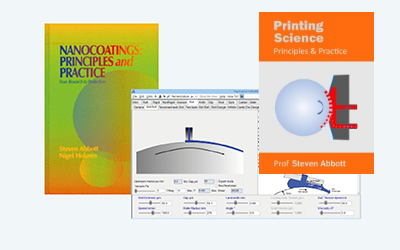Particle Rheology - MCT
Quick Start
Mode Coupling Theory (MCT) is especially insightful about low shear viscosities of particle suspensions. There are two effects: "hydrodynamic" is simply the particles having to move through the liquid; "Brownian" is about particle-particle dynamics. This is an older version. For a more complete guide, go to my Practical Rheology pages.
Particle Rheology - MCT
The inspiration for this app is the wonderful Introduction to Colloidal Suspension Rheology webinar by Prof Norman Wagner from U Delaware and a paper1 mentioned in the webinar. The interest here is that at low shear rates the viscosity (relative to that of the liquid) depends first on the "hydrodynamic" effort required to get particles to flow through a liquid. This follows the equation:
ηrel = 1 + 2.5φ + 5.9φ²
The second effect is "Brownian", i.e. the effects of particles bumping into each other. The total viscosity of the two effects is modelled via Mode Coupling Theory. It depends on a "glass transition" φg which I've set at 0.58. The MCT equation for the Low Shear relative viscosity is:
ηrel = η∞' + 0.9φ²(1-φ/φg)-2.46
The "infinite shear" (high frequency) value is given by:
η∞' = (1+1.5φ*(1+φ-0.189*φ²))/(1-φ*(1+φ-0.189φ²))
Obviously the pure Brownian effect is obtained by subtraction of the hydrodynamic values.
The app simply shows the total and the two effects, that's why there are no controls. I personally find it fascinating and insightful - and wanted to see the equations for myself.
At higher shear rates, the Brownian effects are swept aside as irrelevant, there is strong shear thinning (as shown in the Particle Rheology app) so there is only rather ordered hydrodynamic flows (traffic flowing smoothly down a multi-lane highway, using an analogy from the webinar). The High Shear curve uses the same equation as the Low Shear curve but with φg set to 0.71, a value that also appears in the Particle Rheology app.
But for those particles that have insufficient charge or steric stabilization, at very high shear rates, the viscosity increases dramatically (shear thickening). This is due to the particle passing from the hydrodynamic mode into "lubrication dynamics" where "hydroclusters" form, spanning a large physical space and, therefore, giving a high viscosity. A large part of the science of using high solids particulates depends on fighting these self-association effects which further complicate matters by generating thixotropy etc.
1William B. Russel, Norman J. Wagner, and Jan Mewis, Divergence in the low shear viscosity for Brownian hard-sphere dispersions: At random close packing or the glass transition?, Journal of Rheology 57, 1555-1567, (2013);


